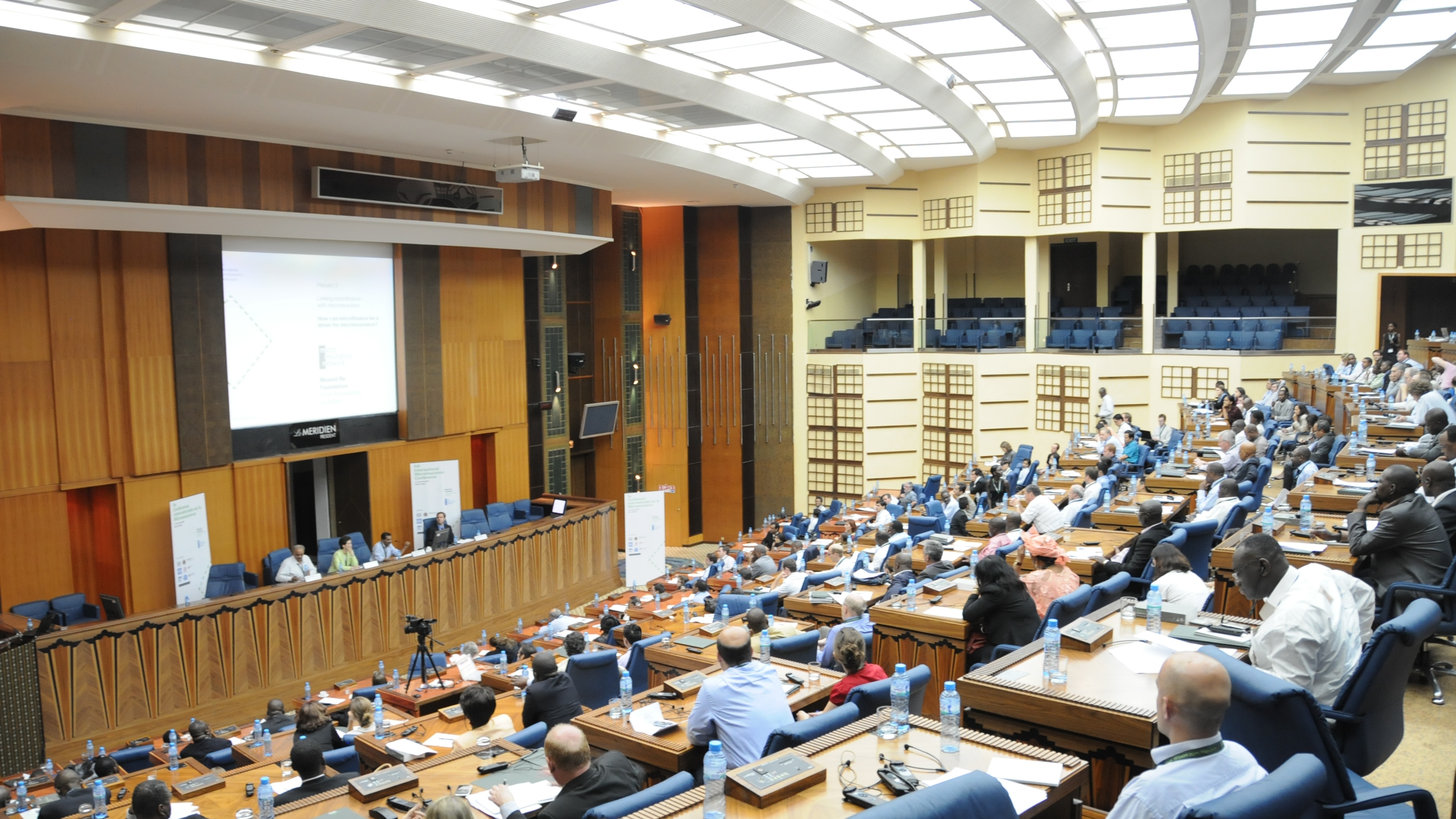
International Conference on Inclusive Insurance
Digital Edition
2 - 6 November 2020
#ICII2020
properties.trackTitle
properties.trackSubtitle
Pandemic shows the urgency for inclusive insurance
Inclusive insurance in light of a pandemic
The COVID-19 crisis threatens the livelihood of the poor around the world. The World Bank estimates that COVID-19 could push 150 million more people into extreme poverty. Meanwhile, the economic crisis forces governments to reduce aid budgets. The International Conference on Inclusive Insurance 2020 – Digital Edition took place at a very difficult time, both on a personal level for millions of people, but also for the insurance industry as a whole. According to keynote speaker Achim Steiner, Administrator of the United Nations Development Programme, global human development is set to decline in 2020 for the first time in a generation. “At this critical moment, inclusive insurance can play a vital role in getting the Sustainable Development Goals back on track by protecting lives and livelihoods, reducing poverty, increasing financial inclusion, and empowering women”, said Steiner
Like any other industry, the pandemic has significantly affected not only insurance clients but also the operations of insurers. Experts agreed that one of the main challenges to come out of the pandemic was distribution and servicing, followed by ineffective cover for clients. Most people working in the informal sector have no social security protection and have been hardest hit economically by the pandemic. Operations closed down, making service and delivery difficult. Some providers reported that clients were afraid to go to hospital, and even if they did, it was hard to file claims and get them processed.
Keynote from Achim Steiner at the #ICII2020 - Digital Edition
Watch the video to listen to the Keynote from Achim Steiner, Administrator of UNDP, at the ICII 2020.
The results of the recent “Landscape of Microinsurance Study” were presented by the Microinsurance Network, which analysed the pre-COVID inclusive insurance market. Based on figures from 2019, the market shows four main characteristics. The rise of low-cost health products, especially hospital cash plans, continues. More and more stakeholders are focusing on climate risk insurance, which some years ago was not at the centre of discussions. Digitalisation is becoming increasingly important, but concerns remain as to how much “human touch” is needed. Furthermore, the results of the landscape study have raised a few concerns about the value of some existing products, a number of which had shown extremely low claims.
Going digital – the need for speed
There is an urgency for digital inclusion in order to access services online and via mobile. “The pandemic has made us ask whether digital works for everyone and has made digitalisation urgent”, experts commented. Technology can be a game-changer for people with no experience of any financial services, let alone insurance. The number and variety of tech players has grown significantly, right across the insurance value chain. Insurance providers and intermediaries from India reported that there has been a transition, with more people using FinTech products and e-commerce. This in turn helps insurers understand which products work for which specific consumer segments. According to the National Insurance Commission of Ghana, 65% of inclusive insurance products in the country are being sold via mobile insurance. New players such as WhatsApp in India explore insurance and payment services, and automated chatbots have started to replace human interaction. Insurers in Asia use Facebook to engage with insurers’ claims processes, and digital marketing and influencers instead of face-to-face sales agents. For industry players, digitalisation requires continuous investments as technology evolves rapidly, as well as space for innovation, new partnerships, and a huge effort in learning.
Digitalisation brings new challenges for supervisors and governments, particularly in terms of assessing the value of products, partnerships, consumer protection, and effective supervision. An enabling regulatory environment plays a key role. Allowing enough space for innovation – for example, through the “sandbox approach” – is a critical success factor. In addition, the pandemic has kept regulators busy, with new ways of working and demands from industry to relax regulations. On the upside, approval processes were sped up and more products developed as a result of the pandemic. But success relies on other enablers, including digital payment infrastructure, consumer education, innovative providers, digitally empowered consumers, and financial inclusion strategies.
But how much digital works? Mobile phones allow the integration of financial services and insurance with additional services, such as access to health services. Certainly the rise of integrated solutions is promising, but people do not wake up in the morning wanting to buy insurance. Insurance needs to be explained. Experts agree that the distribution and servicing of inclusive insurance products still requires a “personal touch”, despite all the advantages of digitalisation. APA Insurance in Kenya, for example, still reaches a large part of its clients through “feet on the street”, such as agri-input companies, churches, NGOs and development agencies, community-based resources, and “VIPs” – village insurance promoters who go into the market and work seasonally to build their own low-cost channels. At the same time, due to poor infrastructure and internet access, insurance providers recommend that every online application should have an offline mode.

And the climate keeps changing
The most vulnerable low-income communities, however, are facing an even bigger challenge than the current pandemic, namely climate change. Warmer temperatures increase the frequency of extreme weather events. Experts have therefore called upon the industry, governments and donors to step up their efforts to develop the inclusive insurance market and to expand outreach to affordable risk management solutions.
Three aspects played a key role during the discussions at the ICII 2020: partnerships, layering of risk management solutions and an integrated risk management approach. Examples from agricultural insurance schemes in India or Uganda have shown that PPPs can successfully reach millions of farmers. The key challenges of PPPs, however, continue to be high transaction costs, long-term efficiency, sustainability and unclear roles of the different stakeholders involved in the project. Clients need different products for different risks, including insurance as well as savings and credits. Savings are most suitable for expected or planned expenses. Insurance is more suitable for large, unplanned losses, while loans can also be used to plug the gap, but only if a household has repayment capacity. Insurance should be integrated into a broader package of risk management and transfer solutions. Risk awareness and risk reduction are key to making insurance affordable. The combination of micro, meso and macro solutions, such as the cooperation between Guardian Insurance and the CCRIF, can provide an ever stronger protection against different shocks. Meso-level examples, where agri-businesses, banks and microfinance institutions (MFIs) take out cover not only for their own risk management, have helped to increase client productivity and sustainability. However, according to the findings of the latest Landscape of Microinsurance study, the availability of reliable data, affordability and product value remain critical challenges and are certainly reasons for the again extremely low coverage.
What’s next?
The pandemic has had a strong negative impact on the economic situation of the poor, and has highlighted the urgent need for more affordable risk management solutions. As announced by Achim Steiner, UNDP’s Insurance and Risk Finance Facility will be working in at least 20 countries, and focusing on comprehensive inclusive insurance, from an enabling environment and market development, through to the development and deployment of new instruments, and impact measurement. National financial inclusion strategies can play an essential role in rolling out inclusive insurance. Regulators will have to play a dual role in both supervision and market development. The COVID-19 crisis has again underlined the urgency for regulators to facilitate digitalisation, whilst balancing consumer protection.
“If we understand the urgency, we can act”, said Doubell Chamberlain, Chairman of the Microinsurance Network. For Denis Duverne, Chairman of Axa and Chairman of the Insurance Development Forum, inclusive insurance is not just regular insurance from mature markets and made small. It has to be simpler. He also called for a look beyond climate change. “You can’t just look at climate risk, you have to look at health and protection”, he said, adding that PPPs will be essential. Vijay Shah, Chairman of the Association of Insurers and Reinsurers in Developing Countries believes that “the demand for medical and health products will transform the insurance industry.”
Overall, experts agreed that inclusive insurance needs a long-term approach. Massive use of technology, new approaches in distribution and a strong cooperation between the private sector, governments and regulators – beyond financial incentives – are key to success. In the context of COVID-19, the need for innovation and affordable and sustainable products that create value for the customer is even greater. Inclusive insurance has a crucial role to play. Otherwise, even more people will fall back into poverty.
About the ICII 2020 - Digital Edition


Read more about our previous conferences
General enquiries about the conference: info@munichre-foundation.org
| Year | Name | Country |
|---|---|---|
| 2019 | 15th International Conference on Inclusive Insurance | Bangladesh |
| 2018 | 14th International Microinsurance Conference | Zambia |
| 2017 | 13th International Microinsurance Conference | Peru |
| 2016 | 12th International Microinsurance Conference | Sri Lanka |
| 2015 | 11th International Microinsurance Conference | Morocco |
| 2014 | 10th International Microinsurance Conference | Mexico |
| 2013 | 9th International Microinsurance Conference | Indonesia |
| 2012 | 8th International Microinsurance Conference | Tanzania |
| 2011 | 7th International Microinsurance Conference | Brazil |
| 2010 | 6th International Microinsurance Conference | Philippines |
| 2009 | 5th International Microinsurance Conference | Senegal |
| 2008 | 4th International Microinsurance Conference | Colombia |
| 2007 | 3rd International Microinsurance Conference | India |
| 2006 | 2nd International Microinsurance Conference | South Africa |
| 2005 | 1st International Microinsurance Conference | Germany |












